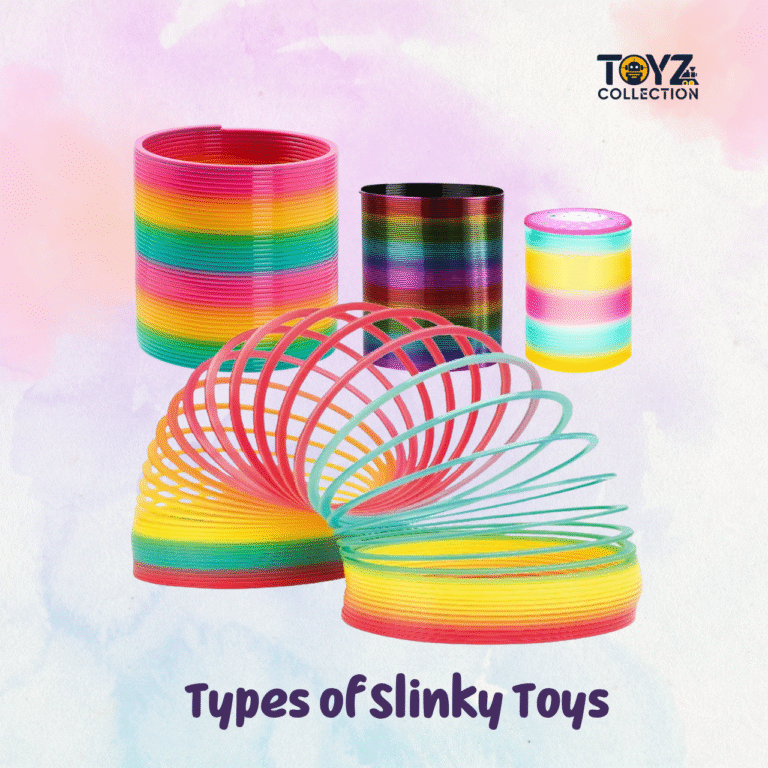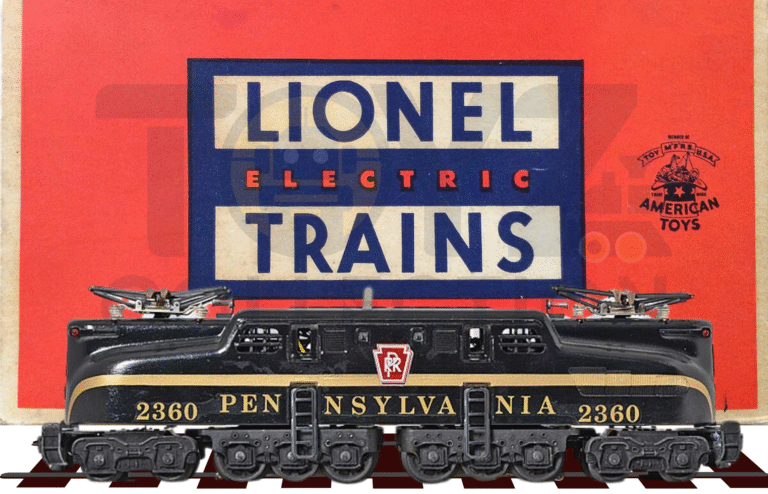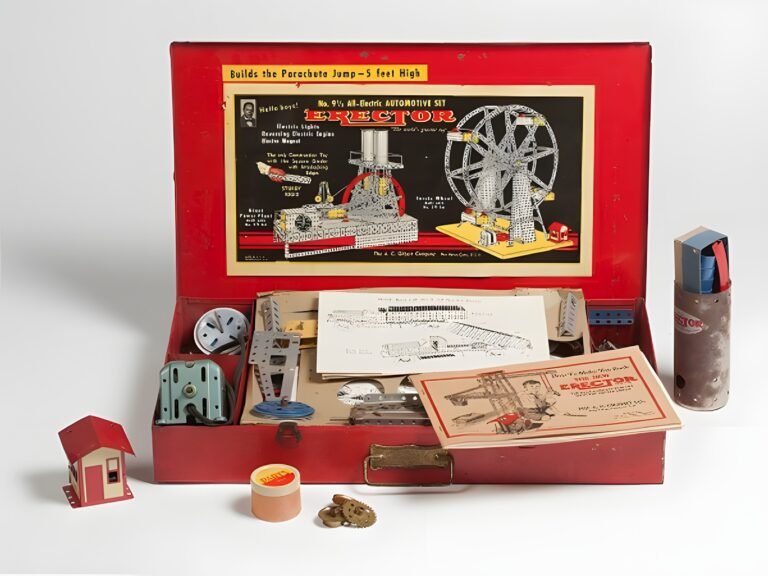You’re a kid, excited to open a brand-new toy box.
You lift the lid, expecting action figures or building blocks.
But inside… is a glowing chunk of uranium.
Yep, actual radioactive material.
Back in 1950, the A.C. Gilbert Company made a toy called the Gilbert U-238 Atomic Energy Lab Kit. This wasn’t a pretend science set. It had actual radioactive ore, a Geiger counter, a cloud chamber, and tools to see nuclear particles. You were meant to play with radiation.
Sounds crazy, right? But it’s true.
This toy was made to teach you atomic science.
Now, it’s called the most dangerous toy in the world. Even Time Magazine said that in 2006.
This kit cost about $49.50 back then. That’s like $500 today! Parents didn’t love it. Only around 500 kits were sold. It was pulled from the market soon after.
Today, it’s not just a toy. It’s a famous piece of history, found in museums, on warning lists, and in articles like this one.
Let’s look deeper into this wild toy story.
What Was the Radioactive Atomic Energy Lab Kit?
The Wild Idea Behind the Toy
Let’s go back to the 1950s. People were excited about atomic energy. They saw it as the future.
Back then, the world had just seen the power of the atomic bomb. But instead of fear, many felt wonder. They believed nuclear science could help us. It could light cities, cure illness, even fly rockets. So, everyone from big scientists to little kids, wanted to learn about it.
That’s where the Radioactive Atomic Energy Lab Kit came in.
This toy was made to teach science to kids. Real science. Not fake or plastic stuff. The kit had real tools. Real science steps. And yes, real radioactive materials.
It was created by the A.C. Gilbert Company. They didn’t want to scare you. They wanted to make you curious, smart, and ready for the future. Their idea?
“Give kids a toy that makes them think like a nuclear scientist!”

Who Was A.C. Gilbert?
Now meet the man behind this crazy toy: Alfred Carlton Gilbert, or just A.C. Gilbert.
He wasn’t just a toy maker. He was also a magician, a businessman, and even an Olympic gold medalist! But most of all, he loved teaching kids with real, hands-on fun.
Before the atomic kit, he made the famous Erector Set, a build-it-yourself toy with metal parts and motors. It helped kids understand machines by letting them build one.
With the Gilbert U-238 Atomic Energy Lab, he took the same idea learn by doing, and turned it into a science kit. A real one. With tools used in labs and radioactive rocks used in experiments. He truly believed that kids could handle real science if they were taught the right way.

What Did the Radioactive Atomic Energy Lab Kit Include?
When you opened the Gilbert U-238 Atomic Energy Lab Kit, here’s what you found:
- Four Uranium Ore Samples – Real bits of U-238 rock
- Geiger Counter – A tool that “clicks” when it detects radiation
- Cloud Chamber – A clear box where you can actually see atomic particles
- Electroscope – Measures electric charge from radioactive decay
- Spinthariscope – Let’s you watch tiny flashes as atoms break apart
- Instruction Manual & Comic Books – Fun guides that taught you nuclear science
And here’s a quick look at what each item did and how risky it really was:
| Item | What It Did | Danger Level |
| Uranium Ore Samples | Showed real radiation source | Very High |
| Geiger Counter | Detected atomic particles | Low (tool only) |
| Cloud Chamber | Made particle trails visible | Moderate (no protect.) |
| Electroscope | Measured charge from decay | Low (passive tool) |
| Spinthariscope | Displayed tiny light flashes | Low (shielded view) |
| Manual & Comic Books | Explained how to use the kit | Safe (just paper) |

Was the Radioactive Atomic Energy Lab Kit Really Dangerous?
Yes, it was dangerous. The Radioactive Atomic Energy Lab Kit looked like a fun science toy, but it had real risks.
What Made It Dangerous?
Inside the kit were four uranium ore samples. Uranium is radioactive. This means it gives off invisible rays called radiation. These rays can hurt your body if you get too much of them.
Radiation is tricky because you can’t see, smell, or feel it. But it can damage your cells inside. That can cause sickness or even worse problems later.
The kit also had tools like the Geiger counter, which clicks when it finds radiation. If you heard a lot of clicking, it meant radiation was nearby.
But here’s the problem:
- There were no gloves to protect your hands.
- No goggles to protect your eyes.
- No warnings about how long you should play with it.
Kids just had to learn by themselves, with little safety advice.

What Did Experts Say?
Years later, experts looked back and said this toy was unsafe.
In 2006, Time Magazine named it the “most dangerous toy ever made.” The Bulletin of the Atomic Scientists said it was a big mistake to sell a toy with real radioactive material to kids.
Even if the radiation was low, long exposure can be harmful. Since kids didn’t have safety gear or clear instructions, this made it risky.
Why Was the Radioactive Atomic Energy Lab Kit Ever Sold to Kids?
In the 1950s, people were amazed by atomic energy. It felt like magic and the future all at once. The world had just seen the power of the atomic bomb, and many believed atomic science could change life for the better.
Because of this excitement, companies wanted to bring that wonder to kids. The A.C. Gilbert Company thought, “Why not make a toy that lets children learn about real atomic science?”
Back then, safety rules were not very strong. Adults believed it was good to teach kids about science early. So, toys like the Radioactive Atomic Energy Lab Kit were made to be both fun and educational.
Ads called it the “most educational toy ever made.” They promised kids could become “young scientists” and explore the secrets of atoms right at home.
The toy reflected the big hopes of America’s Atomic Age, a time when everyone believed atomic power could build a better future.

What Did the Radioactive Atomic Energy Lab Kit Cost Back Then?
When the Radioactive Atomic Energy Lab Kit came out in the 1950s, it wasn’t cheap. It cost around $50 to $60 back then. That might not sound like much today, but it was a lot of money for a toy.
To put it in perspective, $50 in 1950 is like $600 or more today. This meant only some families could afford it. The kit was more like a serious science tool than a simple toy.
Because of the price and the real radioactive materials inside, the kit was made in limited numbers. Today, finding a complete original kit is very rare.
Price and Rarity Breakdown
| Year | Price Then | Price Today (Approx.) | Rarity Today | Why? |
| 1950s | $50 – $60 | $600+ | Limited | Expensive toy with real radioactive parts |
| Today | N/A | $2,000 – $10,000+ | Very Rare | Collectors prize original kits highly |
What Did the Flyers and Ads Say About the Radioactive Atomic Energy Lab Kit?
Back in the 1950s, the Radioactive Atomic Energy Lab Kit was advertised with big, bold promises. The flyers made it sound like the most exciting science adventure you could ever have at home.
The ads called it:
“The most thrilling scientific toy ever!”
“Safe! Fascinating! Instructive!”
One flyer even claimed:
“See paths of atomic particles… do experiments just like real scientists!”
The images in the ads showed happy boys in ties and lab coats, standing proudly with their Geiger counters and uranium samples. The toy looked like a real science lab in a box. It promised fun, learning, and a bright atomic future.
Key Features Highlighted in the Ads:
| What the Flyer Promised | What It Meant |
|---|---|
| Real Uranium Ore Samples | Kids could handle radioactive rocks |
| Cloud Chamber to See Particles Move | You could “watch” radiation in action |
| Electroscope and Geiger Counter | Tools to measure radiation at home |
| Booklets on Atomic Experiments | Instructions for real science tasks |
These ads didn’t talk much about radioactivity risks. Instead, they focused on how the toy could make you feel like a young nuclear physicist.
Looking back, these ads are both fascinating and shocking. They reflect how people once trusted atomic energy without fully understanding the dangers.


How Did the Public React to the Radioactive Atomic Energy Lab Kit?
When the Radioactive Atomic Energy Lab Kit first came out, many people were excited. They saw it as a fun way to learn about atomic science and the amazing power of radioactivity. Parents liked that kids could explore real science at home. Schools even used similar kits to teach students.
But not everyone was happy. Some scientists and doctors worried about the dangers. They said kids might get too much exposure to radiation without knowing it. Safety rules were not strict back then, so many risks were overlooked.
Years later, when people learned more about radiation’s harm, opinions changed. The toy became famous for being one of the most dangerous toys ever sold. It’s now seen as a warning about how little was understood about radiation in the Atomic Age.
Today, collectors and museums see the kit as a rare piece of history, a mix of wonder and risk from a time when atomic science was new and exciting.
What Lessons Did the Radioactive Atomic Energy Lab Kit Teach Us About Science and Safety?
The Radioactive Atomic Energy Lab Kit wasn’t just a toy, it was a powerful lesson from history. It showed us how much we still needed to learn about radioactivity and science safety.
Science Can Be Exciting, But Also Dangerous
This kit brought atomic science right into your home. You could see real uranium, detect radiation with a Geiger counter, and watch atomic particles dance in the cloud chamber. That’s amazing!
But it also taught us a big truth: science isn’t always safe without care. The kit lacked safety gear like gloves and goggles. It didn’t warn you about long exposure to radioactive materials.
Today, thanks to lessons from this toy, we know to respect the power of atoms. Scientists now use strict rules to keep everyone safe when working with radioactive materials.
The Legacy of A.C. Gilbert’s Atomic Toy
The man behind the kit, A.C. Gilbert, wanted to inspire kids to love science. And he did! But his toy also reminds us that even good intentions need strong safety.
The Atomic Age was full of hope and curiosity. The kit captured that spirit perfectly, mixing wonder with risk.
Why This Matters for You
If you’re curious about science, this story shows you both the thrill and the caution. Real science can change the world, but it must be handled carefully.
So next time you hear about nuclear power or radioactivity, remember the toy that taught kids about atoms… and taught the world about respect for science.
How Does the Radioactive Atomic Energy Lab Kit Compare to Today’s Science Kits?
Today, science kits are safe, fun, and made for curious kids like you. They teach with LEDs, magnets, and safe chemicals. But none come close to the real risk and wonder of the Radioactive Atomic Energy Lab Kit.
Back in the 1950s, kids handled actual uranium ore and saw real radiation. That was wild! Now, safety rules keep radioactive materials out of kids’ hands. Instead, today’s kits use fake but cool science to spark curiosity safely.
The Radioactive Atomic Energy Lab Kit stands as a bold reminder: science kits are for learning, but safety is the top rule. You can love science and still be smart about it!
Why Collectors and Museums Treasure the Radioactive Atomic Energy Lab Kit Today
Even though it was dangerous, the Radioactive Atomic Energy Lab Kit is now a prized collectible. Why? Because it’s a rare glimpse into a wild time when science and play mixed in a way no one expected.
Museums like the Smithsonian and the Atomic Testing Museum display these kits to show how people once viewed atomic power, with awe, hope, and a bit of risk.
Collectors hunt original kits because they are rare and tell a story of a world fascinated by atoms. A complete kit can sell for thousands of dollars today!
This toy isn’t just a relic, it’s a story about human curiosity, bravery, and the lessons learned about science and safety.
Why Did A.C. Gilbert Create the Radioactive Atomic Energy Lab Kit?
A.C. Gilbert, the man behind the Radioactive Atomic Energy Lab Kit, was a scientist and toy maker who loved to teach kids about science. He believed learning should be fun and hands-on.
After World War II, America was filled with excitement about atomic energy and the future. Gilbert wanted to bring that excitement into homes and inspire a new generation of scientists.
He thought, “Why not let kids explore real atoms and radioactivity safely?” So, he designed the kit to show the magic of the atomic age up close, with real uranium ore, a Geiger counter, and even a cloud chamber to watch particles.
His goal was to turn children into “young scientists,” sparking curiosity and wonder about the world’s tiniest building blocks.
Gilbert didn’t fully understand how dangerous the radiation was. Back then, radiation was seen more as a curiosity than a hazard.
The kit reflected his hope: that science could be exciting, inspiring, and lead to a better future.
Conclusion
The Radioactive Atomic Energy Lab Kit was unlike any other toy. It brought real uranium and radiation into children’s hands during the hopeful but risky Atomic Age. Though made with good intentions by A.C. Gilbert, the kit showed how little was known about radioactivity safety in the 1950s.
Today, it stands as a powerful reminder: science is amazing, but it must always be handled carefully. The kit’s story teaches us to respect the power of atoms and the importance of safety in science.
If you love science, remember the lessons of this dangerous toy, curiosity is great, but safety comes first.
It contained real uranium ore and emitted radioactive rays, which can harm your body if exposed too long without protection.
It was created by A.C. Gilbert, a toy maker and scientist passionate about teaching kids real science.
The kit cost about $50 to $60, which is around $600 today — making it expensive and rare.
During the Atomic Age, many were excited about atomic science and wanted kids to learn about it hands-on, despite the risks.
Yes, but they are very rare and valuable. Collectors and museums prize them for their history and uniqueness.
It showed that science is fascinating but must be handled safely. It also reminded us how far we’ve come in understanding radioactivity dangers.
Before the Atomic Energy Lab Kit shocked the world, A.C. Gilbert had already changed how kids played with the Gilbert Erector Set – a toy that taught real engineering.



